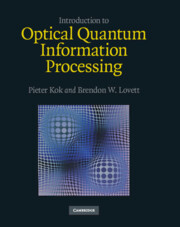Book contents
- Frontmatter
- Dedication
- Contents
- Preface
- Part I Quantum optics and quantum information
- Part II Quantum information in photons and atoms
- 4 Photon sources and detectors
- 5 Quantum communication with single photons
- 6 Quantum computation with single photons
- 7 Atomic quantum information carriers
- Part III Quantum information in many-body systems
- Appendix A Baker–Campbell–Haussdorff relations
- Appendix B The Knill–Laflamme–Milburn protocol
- Appendix C Cross–Kerr nonlinearities for single photons
- References
- Index
4 - Photon sources and detectors
from Part II - Quantum information in photons and atoms
Published online by Cambridge University Press: 05 July 2014
- Frontmatter
- Dedication
- Contents
- Preface
- Part I Quantum optics and quantum information
- Part II Quantum information in photons and atoms
- 4 Photon sources and detectors
- 5 Quantum communication with single photons
- 6 Quantum computation with single photons
- 7 Atomic quantum information carriers
- Part III Quantum information in many-body systems
- Appendix A Baker–Campbell–Haussdorff relations
- Appendix B The Knill–Laflamme–Milburn protocol
- Appendix C Cross–Kerr nonlinearities for single photons
- References
- Index
Summary
In optical quantum information processing, two of the most basic elements are the sources of quantum mechanical states of light, and the devices that can detect these states. In this chapter, we narrow this down to photon sources and photodetectors. We will describe first how detectors work, starting from abstract ideal detectors, via a complete description of realistic detectors in terms of POVMS, to a brief overview of current photodetectors. Subsequently, we will define what is a single-photon source, and how we can determine experimentally whether a source produces single photons or something else. Having laid down the ground rules, we will survey some of the most popular ways photons are produced in the laboratory. Finally, we take a look at the production of entangled photon sources and quantum non-demolition measurements of photons.
A mathematical model of photodetectors
Photodetectors are devices that produce a macroscopic signal when triggered by one or more photons. In the ideal situation, every photon that hits the detector contributes to the macroscopic signal, and there are no ‘ghost’ signals, or so-called dark counts. In this situation we can define two types of detector, namely the ‘photon-number detector’, and ‘detectors without number resolution’.
First, the photon number detector is a (largely hypothetical) device that tells us how many photons there are in a given optical mode that is properly localized in space and time. This property is called ‘photon-number resolution’.
Information
- Type
- Chapter
- Information
- Introduction to Optical Quantum Information Processing , pp. 113 - 144Publisher: Cambridge University PressPrint publication year: 2010
